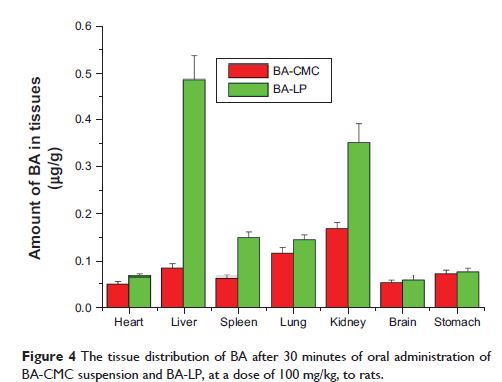9 0 5 7 8
论文已发表
注册即可获取德孚的最新动态
IF 收录期刊
- 2.6 Breast Cancer (Dove Med Press)
- 3.9 Clin Epidemiol
- 3.3 Cancer Manag Res
- 3.9 Infect Drug Resist
- 3.6 Clin Interv Aging
- 4.8 Drug Des Dev Ther
- 2.8 Int J Chronic Obstr
- 8.0 Int J Nanomed
- 2.3 Int J Women's Health
- 3.2 Neuropsych Dis Treat
- 4.0 OncoTargets Ther
- 2.2 Patient Prefer Adher
- 2.8 Ther Clin Risk Manag
- 2.7 J Pain Res
- 3.3 Diabet Metab Synd Ob
- 4.3 Psychol Res Behav Ma
- 3.4 Nat Sci Sleep
- 1.9 Pharmgenomics Pers Med
- 3.5 Risk Manag Healthc Policy
- 4.5 J Inflamm Res
- 2.3 Int J Gen Med
- 4.1 J Hepatocell Carcinoma
- 3.2 J Asthma Allergy
- 2.3 Clin Cosmet Investig Dermatol
- 3.3 J Multidiscip Healthc

已发表论文
黄芩苷脂质体的制备、药代动力学和生物分布
Authors Wei Y, Guo J, Zheng X, Wu J, Zhou Y, Yu Y, Ye Y, Zhang L, Zhao L
Published Date August 2014 Volume 2014:9(1) Pages 3623—3630
DOI http://dx.doi.org/10.2147/IJN.S66312
Received 16 April 2014, Accepted 24 May 2014, Published 1 August 2014
Abstract: Baicalin (BA) is a major constituent of Scutellaria baicalensis Georgi , a medicinal herb. Previous pharmacokinetic studies of BA showed its low oral bioavailability. The aim of the present study was to develop a novel BA-loaded liposome (BA-LP) to enhance oral bioavailability. BA-LP, composed of BA, Tween® 80, Phospholipon® 90H, and citric acid at weight ratio of 96/50/96/50, respectively, was prepared by the effervescent dispersion technique and characterized in terms of morphology, size, zeta potential, encapsulation efficiency, and the in vitro release. Pharmacokinetics and biodistribution studies were carried out in rats after oral administration of BA-LP and a carboxymethyl cellulose suspension containing BA (BA-CMC) as a control. BA-LP exhibited a spherical shape by transmission electron microscopy observation. BA-LP had a mean particle size of 373±15.5 nm, zeta potential of -20.1±0.22 mV, and encapsulation efficiency of 82.7%±0.59%. The BA-LP showed a sustained-release behavior, and the in vitro drug-release kinetic model fit well with the Weibull distribution equation: lnln (1/(1-Q)) =0.609 lnt -1.230 (r =0.995). The oral bioavailability and the peak concentration of the BA-LP was threefold and 2.82-fold that of BA-CMC, respectively. The in vivo distribution results indicated that drug concentrations were significantly increased in the liver, kidney, and lung in the case of BA-LP, which were 5.59-fold, 2.33-fold, and 1.25-fold higher than those of BA-CMC, respectively. In conclusion, the study suggested that BA-LP might be a potential oral drug delivery system to improve bioavailability of BA.
Keywords: nanoliposomes, bioavailability, nanoliposomes, in vitro release, bioavailability, in vivo evaluation
Keywords: nanoliposomes, bioavailability, nanoliposomes, in vitro release, bioavailability, in vivo evaluation
